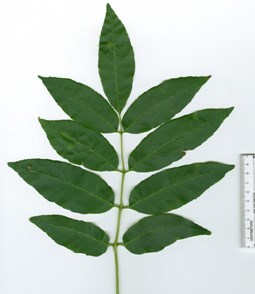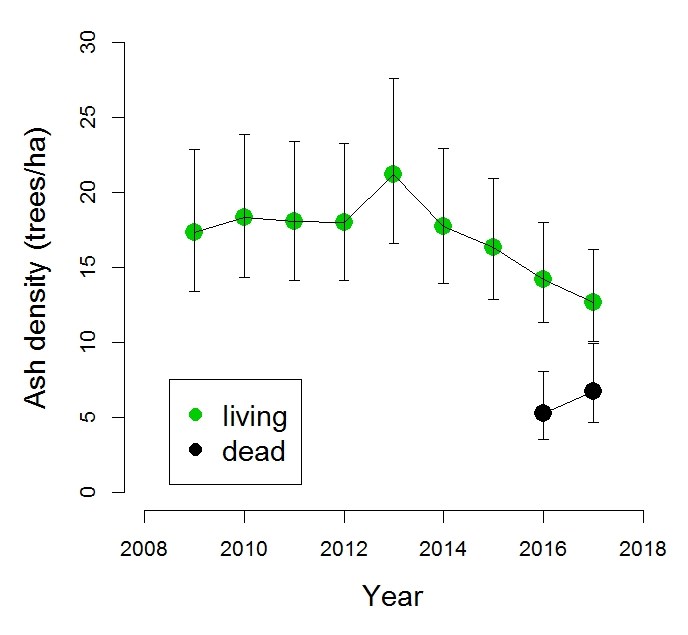Last updated: March 9, 2022
Article
Ash Tree Update 2017
Key Points
- The non-native, invasive emerald ash borer (EAB) infests ash trees and is nearly 100% fatal.
- EAB is present in National Capital Region (NCR) parks and causing the death of thousands of ash trees.
- The loss of ash trees will have cascading effects on forest ecosystems and the plants and animals that live within them.
- Parks are managing damaged ash trees that pose a threat to structures, trails, and roadways.
- Federal agencies are exploring biological controls to combat EAB.

USDA Agricultural Research Service
Background
Emerald ash borer (Agrilus planipennis) is an Asian beetle that targets ash tree species. The adult female lays its eggs on the tree’s bark. After hatching, the larvae bore into the tree and begin feeding on tissues that transport water and sugar within the tree. The destruction of these tissues ultimately kills the tree. In areas of the U.S. where the beetle has been present since the early 2000s, EAB has been fatal to nearly 100% of ash trees.
Ash Trees in 2017
We are now more than ten years into the EAB invasion of National Capital Region (NCR) forests, and ash tree density continues to decline (Figure 1). According to forest data collected by the National Capital Region Inventory and Monitoring Program (NCRN I&M), there were over 300,000 ash trees in NCR’s national park forests before EAB’s arrival. The most recent estimate of the NCR ash population suggests almost 100,000 trees have already been lost to the borer (Table 1). As more trees die, the density of standing dead trees (snags) has increased (Figure 1). We expect that the number of ash snags will peak in the next few years and then decline as standing dead trees ultimately fall to the forest floor. We will continue to track regional ash densities as the effects of the EAB infestation are felt in NCR forests.| Park | # Plots | Live Ash 2010-2013 |
Live Ash 2014-2017 |
Percent Change |
|---|---|---|---|---|
| National Capital Parks - East | 47 | 68,976 | 25,720 | -63 |
| GW Memorial Parkway | 20 | 56,205 | 33,586 | -40 |
| Antietam National Battlefield | 13 | 3,194 | 2,527 | -21 |
| Catoctin Mountain Park | 49 | 48,440 | 38,752 | -20 |
| Monocacy National Battlefield | 15 | 3,112 | 2,490 | -20 |
| Harpers Ferry National Historical Park | 20 | 18,522 | 15,434 | -17 |
| Manassas National Battlefield Park | 17 | 49,585 | 41,756 | -16 |
| C&O Canal National Historical Park | 73 | 73,140 | 64,298 | -12 |
| Rock Creek Park | 19 | 6,046 | 5,441 | -10 |
| Prince William Forest Park | 145 | 7,647 | 7,647 | 0 |
| Wolf Trap National Park for the Performing Arts |
6 | 123 | 123 | 0 |
| National Capital Region TOTAL | 426 | 334,990 | 237,774 | -29 |
Ash Saplings and Seedlings
NCRN monitors ash trees of all sizes, from seedlings, to saplings, to adult trees. The number of individuals in each of these size classes has changed in recent years (Figure 2). The decline in saplings has mirrored that of trees, whereas ash seedling density has spiked. This increase in ash seedlings may be fueled by a prolific seed production year (i.e., a mast year) or park deer management (i.e., reduced deer browse on seedlings). The uptick in seedling density may also reflect stressed canopy trees in decline—evidence of a last gasp of activity and rush to reproduce before the tree dies—or a more favorable environment as dying canopy trees allow more light to reach the small seedlings on the forest floor.
Forest Change with Ash Loss
In natural areas, the loss of ash from the forest canopy will increase light availability in interior forests, which may have cascading ecological effects ranging from increased tree growth rates to invasion by early successional native and nonnative plant species.Another effect of the loss of ash may be changes to or loss of ash-dependent insects. According to Douglas Tallamy’s book “Bringing Nature Home” (2007), ash trees host 150 species of native moth and butterfly larva. Birds and other wildlife depend on these caterpillars for food. Ash seeds are also a food resource for a variety of birds and small mammals.
In the NCR, there are at least 27 insects that are restricted to ash species. In addition to Lepidoptera (butterflies and moths), they belong to the taxon Acari (a group of arachnids that contains mites and ticks), Coleoptera (beetles), Diptera (true flies), Hemiptera (true bugs such as the cicadas, aphids, planthoppers, leafhoppers, and shield bugs), and Hymenoptera (sawflies, wasps, bees, and ants). Another 13 insects in NCR are known to use only ash as a host.
Biological Controls
Although insecticides can be effective in protecting ash trees from EAB damage in unaffected areas, this labor intensive, individualistic approach isn’t realistic for the thousands of ash trees in the NCR forests. However, all hope is not lost. The U.S. Department of Agriculture’s Biocontrol Program is exploring biological control (biocontrol) options as a longterm management strategy for EAB. Biocontrols are natural enemies of a pest that target only that pest.The main focus of biocontrol efforts has been on identifying parasitoid wasps that attack EAB in its native range. Parasitoids are highly specialized, stingless wasps that lay eggs on immature stages of a host insect. The immature wasp then feeds on the host insect (in this case, EAB) and kills it. Four species of parasitoid wasps from Asia have been identified as promising biocontrol agents, and as of 2017, wasps have been released in 25 states including Maryland, Virginia, West Virginia, and the District of Columbia. It is still too early to tell whether these parasitoid wasps will be able to provide sustained control of EAB populations, but there is some evidence that the parasitoids may be able to protect small ash trees, allowing the tree species to persist in the wild while other management options are developed. Learn more about the development of EAB biocontrols at: https://www.nrs.fs.fed.us/disturbance/invasive_species/eab/control_management/biological_control/.
Scientists are also observing native organisms that may be “learning” to attack EAB. Several native, parasitoid wasp species, for example, have been found attacking EAB larvae in the U.S., and several predatory native beetles have been observed to prey on EAB larvae.
Woodpeckers are also natural enemies of EAB. Research in the U.S. has found that woodpecker consumption can account for 35-40% of EAB mortality. These native birds may also play an important role in keeping EAB populations in check, particularly in conjunction with biocontrol agents.
Further Reading
To learn more about how National Park Service scientists are monitoring the health of parks in the National Capital Region, visit the NCRN I&M website.
This article is based on material published as a 2017 resource brief. A 2016 resource brief preceeded it.
Citations
Tallamy, Douglas. Bringing Nature Home: How Native Plants Sustain Wildlife in Our Gardens. 2007. Timber Press. ISBN-10:0881929921
Tags
- anacostia park
- antietam national battlefield
- baltimore-washington parkway
- catoctin mountain park
- chesapeake & ohio canal national historical park
- fort dupont park
- george washington memorial parkway
- great falls park
- greenbelt park
- harpers ferry national historical park
- kenilworth park & aquatic gardens
- manassas national battlefield park
- monocacy national battlefield
- national capital parks-east
- piscataway park
- prince william forest park
- rock creek park
- wolf trap national park for the performing arts
- ash
- fraxinus americana
- emerald ash borer
- agrilus planipennis
- invasive species
- insect
- invasive pests
- ncrn
- i&m
- forest pests
- forest
- resilient forest management
